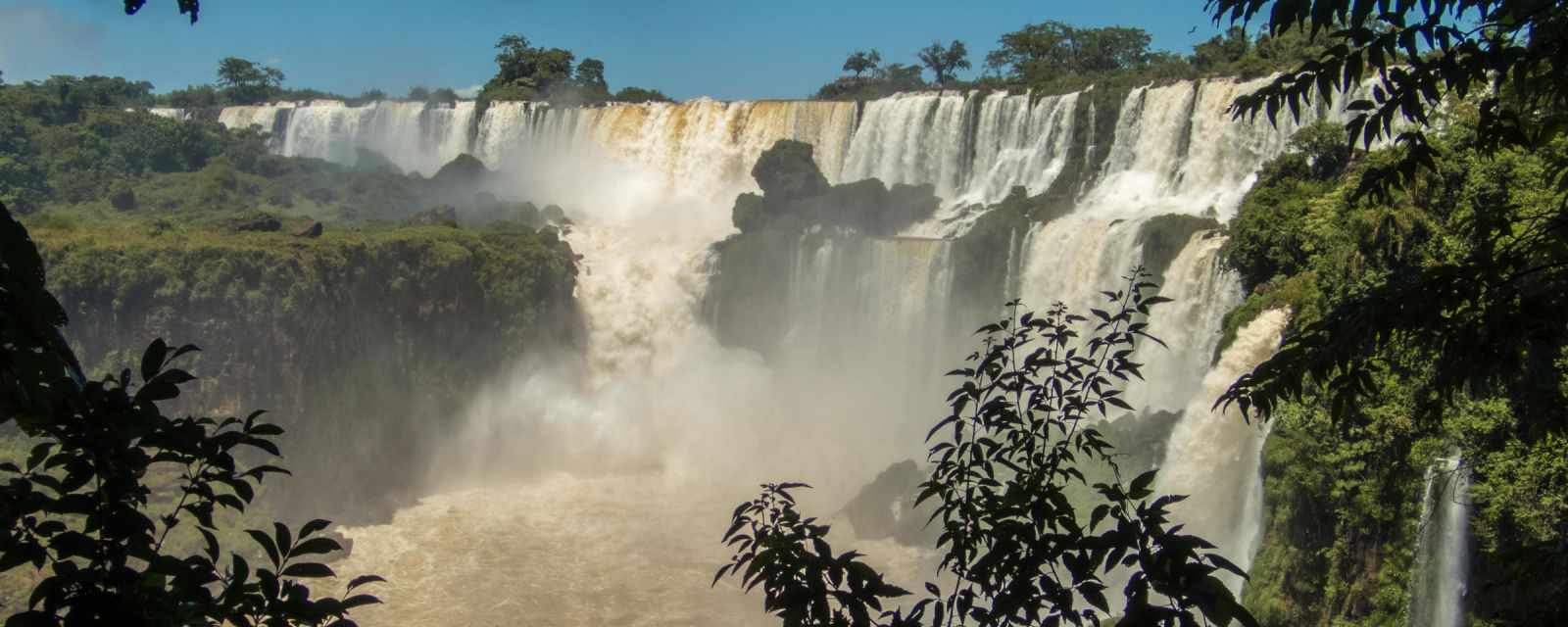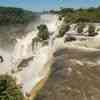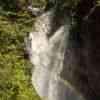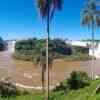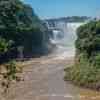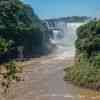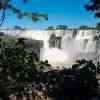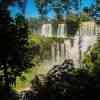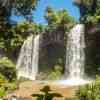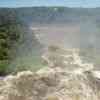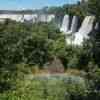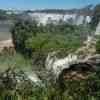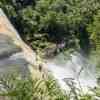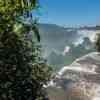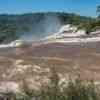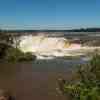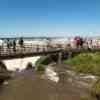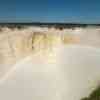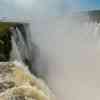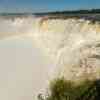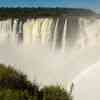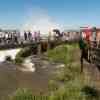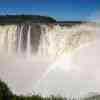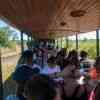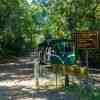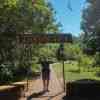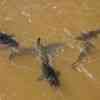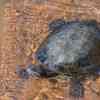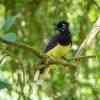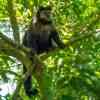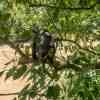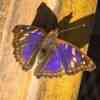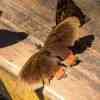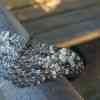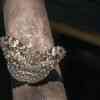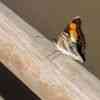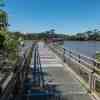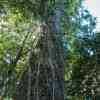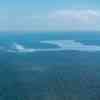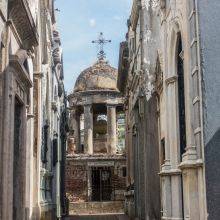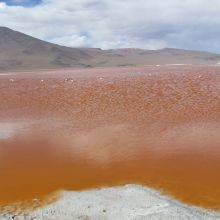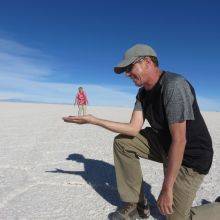When Is the Best Time
Make your Iguazu visit unforgettable. Iguazu is a place that is on everybody's bucket list. Get the most out of your vacation and get all insights from my visits and speaking with locals.
The best time to visit Iguazu regarding the weather is April to September. Most pleasant are June to September, around 75°F/ 24°C and lower humidity.
During the driest time of the year, the falls are clearer less brown from the soil. After heavy rain, the falls appear red-brown from the washed-out soil. Eastern, June, and July are busy because of the winter break.
Also, check out the long public holiday weekends when Iguazu reaches the maximum capacity. Public Holidays in Argentina
After heavy rainfall, up to 39 million litres of water tumble over every second compared to just 2 million during the driest time. However, rain occurs throughout the year. In June 2014, torrential rainfall was the biggest ever recorded flow. Many platforms were closed for safety reasons, and the boardwalk on the Brazilian site was destroyed by the high-water level.
Avoiding Crowds (Worst Time to Visit)
With 1.5 million visitors each year, Iguazu is pretty busy most of the year. Usually, 5 – 6 thousand visitors come here each day. On average, 10 thousand people visit the park daily in the peak season. There are even more visitors during Carnival, Eastern, and on bank holidays, which are on the same days in Argentina and Brazil. The peak season lasts from late December until the end of February (school holidays in Argentina and Brazil). June and July, the winter break is busy as well. If possible, go mid-week. Important Tip: The park gets closed with roughly 12 thousand visitors inside. This can happen during the peak season from midday onwards.
Either you stay in Puerto Iguazu like Casa 24, where we spent several nights or the ideally located Melia Hotel inside the park. This hotel gives you more flexibility to enjoy the beautiful falls. Keep in mind that you have to leave the park and fall at 6 pm like all other tourists. The significant advantage is you are one of the first visitors in the morning. Enjoy the tranquillity of the park before thousands of tourists enter the gate. There is one tour offered in the evening.
These are my recommended tours via GetYourGuide with 24 hours in the advance cancellation policy. Thx for booking via my website! With your support, I am able to provide all information first-hand. Tour prices are at no extra cost!
- Several times a day, speedboat tours take place. These tours are pretty popular. It’s highly recommended to book a tour in advance; if you don't want to risk not getting a spot or waiting for hours which happened to us. Bring a towel and wear flip-flops on the boat if you wish to take part. You definitely get wet on this boat ride.
- A Full Moon tour to Devils’s Throat – Garganta Del Diablo is offered each month. This is the only chance to watch the Iguazu Falls after closure, but currently, it doesn't exist due to Covid19.
The Argentinian side is open from 8 am to 6 pm, but the entrance is already closed after 3 pm. The Brazilian side of the falls opens from 9 am to 5 pm Tip: It's often mentioned that you should be at the ticket counter already before 8 am to avoid queuing. We experienced the opposite. Many people came early and had to wait while we arrived after 9. I have to confess we are not an early riser. It took us just a minute to get the tickets, although it was crowded inside the park.
To take marvellous shots with the perfect sunlight, consider the following order in terms of hiking to the falls:
- Hike to the Lower Falls in the morning
- To the Upper Falls around midday
- To the highlight Devil’s Throat at the end; in the afternoon.
The Iguazu Falls are spectacular with a high flow but more challenging to photograph with many sprays. If it’s scorched, the falls are clear but less impressive. Your best month for a visit depends on what you would like to experience. During the summer season, the level is higher, the falls are utterly impressive, but there is an immense spray, and the falls may be brown-red coloured. During the winter season, from June to September, usually, the falls have a lower level and appear clearer. However, its mother nature and climate change has an impact as well.
Weather
It’s a subtropical and humid climate. The humidity is on average, around 80%. There is a high amount of precipitation throughout the year. The annual rainfall amounts to 1.800 mm. The colder “winter” months are usually a little drier than the hot summer months. Nevertheless, exceptions exist like in June 2014 when torrential rainfall occurred. More daylight during the summer; however, the daylight saving time doesn’t exist any longer in Iguazu.
Increasing temperatures, humidity, and rainfall from October onwards. In October and November, night temperatures are slightly below 20°C/68°F and day temperatures below 30°C/86°F on average. December to March are the warmest months, reaching 32°C/90°F in the shade but can climb up to almost 40°C/104°F. It is hot, and there isn't much shelter in the park. After heavy rainfall, clouds of mist may spoil your view. Due to the heat and humidity, sweating is unavoidable.
In general, April and May are a little wetter than the months before. June, July and August are the driest time of the year. The day temperatures in the so-called winter are ranging from 22-26°C/72-79°F. Days are more pleasant, and nights are pretty cold between 11-16°C/52-61°F. Usually, a fantastic time for Iguazu though the flow can be lower and the falls are less powerful, the pro, the falls are clearer. There is already increasing precipitation in September.
The Iguazu Falls are no longer clear as they were more than 40 years ago, and it is rare to experience them in their natural colour. If you like to see these spectacular falls in their originally colour; visit them in the drier season. Due to forest clearance, the unprotected soil gets washed out into the river. The colour of the falls is frequently brown-red nowadays, especially in the rainy season. Fish can't reproduce because of the harmful side effects; birds and mammals can’t spot their preferred prey. Deforestation has a massive impact on the entire environment.
Best Months to Visit
Location and Tips

The Iguazu Falls are one of the most visited sights in Argentina and truly an unforgettable experience. Iguazu comes from the Guarani language and means "Great Waters". It was declared a National Park in 1939 and World Heritage Site in 1986. Iguazu is also voted as one of the Seven Natural Wonders on earth. The trails and bridges are well maintained the reason that most of the waterfalls on the Argentinian side are accessible for wheelchairs.
On the Brazilian side, helicopter flights are allowed but not in Argentina due to the impact on flora and fauna.
- There is an airport on either side of the falls. In Brazil, the Foz de Iguazu (IGV) is less than 20 km from the town centre. Daily direct flights from Rio de Janeiro are being offered. In Argentina, the airport is called Cataratas del Iguazu (IGR) a bit more than 20 km from the town Puerto de Iguazu. Soon the airport will be enlarged to increase the number of flights and tourists. More direct flights from different cities are planned, not only Buenos Aires.
- After the arrival at the airport, you can either take a taxi, a bus or you’d arrange a pickup. If you stay in the town or nearby, it’s pretty easy and cheap to get to the Iguazu Falls. You can either take a bus for 75 ARS p.p. roughly $ 3,70, or you share a taxi with four for the same amount. Don't forget to ask for the fee first. We once paid three times more than usual in Iguazu due to a taximeter running too fast.
- The third option is to book a shuttle via GetYourGuide. Check the availability and pick up time.
First of all, if you stay only one day, you have to focus on the Argentinian or Brazilian side. Many people arrive by plane in the morning and leave Iguazu with the last plane the same day. I recommend staying at least two better three nights. That way, you can experience all the different lookouts from the platforms and trails on the Argentinian side and visit the Brazilian side, too. You may need a few hours only for the falls on the Brazilian side, but for the Argentinian side, I recommend at least an entire day. The falls are much bigger and more impressive than the Niagara or Victoria Falls IMO. I have seen them all already; the Iguazu Falls are a Must. It's worth the effort to come here and feel the untamed power of mother nature. You can either get by bus or taxi to the Brasilian side. The trail there is quite short and takes 2 hours max. However, the view from there is spectacular and worth the effort, too! Citizens from the US have to pay $ 160 for a VISA if visiting the Brazilian side!
Hiking Trails (Argentinian Side)
There is an ecological train inside Iguazu National Park with two stops. The first stop is just a short ride to the Lower and Upper Falls trailhead and picnic area. Instead, you can walk to the first station just 10 minutes on the Green Trail through a verdant rainforest. The second stop is close to Devil’s Throat - Garganta Del Diablo. Here it’s advisable to take the train for saving time. The hiking trail is just next to the rails, therefore quite boring.
- The Lower Falls trail is 3.4 k/2.1 miles long
- The Upper Falls trail is 3.5 km/2.2 miles long
- The hike to Devil’s throat 2.2 km/1.4 miles, frequently along metal boardwalks. You can already hear the rumble of the cascading water in the distance. Mostly you get utterly wet at the end where the falls tumble down. Even in the rain, the sheer power of the falls is spectacular. Devil's Throat is 14 waterfalls tumbling down more than 80 m/262 feet deep.
- The Macuco Trail, where once the falls were located, now there is just a single waterfall. Trail length 7 km/4.3 miles.
- The trail on San Martin Island doesn’t exist for years now. Usually, you got there by boat to the ideally located island in front of the falls.
Tickets can be purchased online only. Link Tickets
Argentina: Foreigners AR$ 5500/ $ 30 / 27€ - Children (6-16) AR$/ $11 / 10€
Residents/Mercosur countries ARS 1500
Tip: If you'd like to visit the Argentinian side twice, let the entrance ticket be stamped to get a discount of 50 % the next day.
- Comfortable trainer; you will walk the entire day
- Plenty of water; it's warm, and beverages are at some points available only
- Picnic and snacks, there is only fast food offered
- Sun protection and sunscreen, there isn't much shelter
- Insect repellent, or you may get eaten up after rainfall
- Either rain poncho or clothes to change - You'll definitely get soaked! If you plan to make a boat trip, already wear your swimsuit and flip flops for the boat tour and carry a towel
Iguazu Falls National Park Facts
Butterfly salt lick
- The falls are in total 2.7 km/1.7 mi long; 800 m/0.5 mi on the Brazilian side and 1.9 km/1.2 mi on the Argentinian side and mark the border.
- There are up to 270 waterfalls depending on the water level and the flow.
- The falls have a height of 60-82 meters/197-269 feet.
- The Iguazu River originates in Brazil in the state of Parana and is 1.320 km long.
- The Iguazu River flows into the Parana River after the falls at the Paraguayan border.
- 100 species of fish are native to the Iguazu River.
- 2000 different kinds of butterflies exist in the National Park.
- 1000 species of birds call the Iguazu National Park their home.
- The biggest population of great dusky swifts is nesting and resting behind the falls to be protected from predators. You can often spot them flying into the falls in the late afternoon, and that's utterly exceptional.
- Rare and threatened wildlife like the jaguar, tapir, ocelot occurs here.
Please, don’t feed the agoutis and monkeys. Many of them got already used to human food. The result they often become aggressive in the picnic areas and can harm people.
